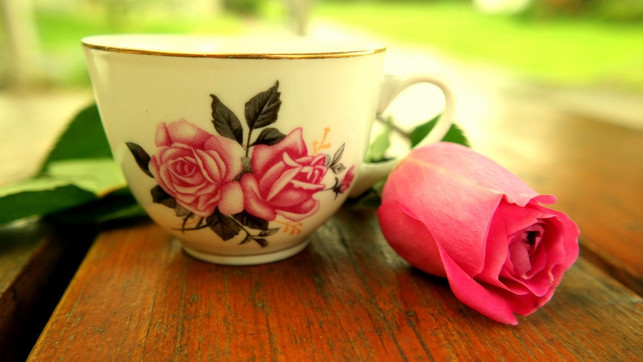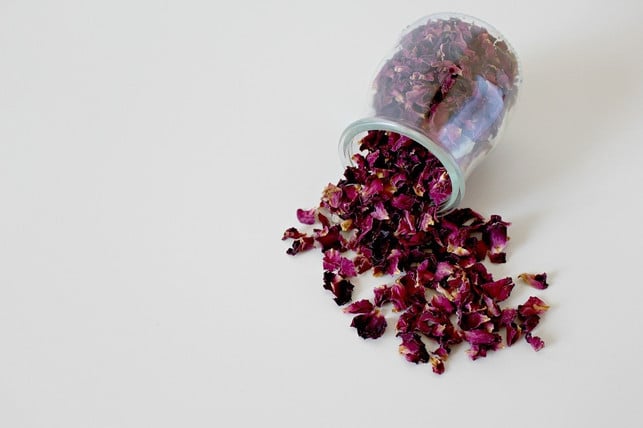
Rose tea not only impresses with its pleasant scent and lovely taste – it also has a positive effect on the body and mind. You can find out everything you need to know about the properties and preparation of rose tea here.
Roses are one of the most popular flowers worldwide. They are a symbol of love and romance. Rose tea, on the other hand, is rather unusual in our culture and is considered a specialty. Not so in the Asian region: Rose tea has long been used and highly valued in Chinese medicine.
In their wild form, roses only thrive in the northern hemisphere. Most roses on the market today are cultivated in Iran or Turkey.
In this article you will find out what is in the delicately scented petals and how rose tea and water infusion work. You will also read how you can make rose tea yourself and what you should pay attention to when preparing it.
This is how rose tea works

Rose tea not only tastes pleasant, the flowers also have healing properties. The composition of rose petals includes valuable ingredients such as:
-
essential oils (especially citronellol and geraniol)
- Flavonoids
- glycosides
The ingredients from rose petals have a positive effect on the mind and body:
- As a review paper by Iranian researchers summarizes, the essential oils present in roses showed pain-relieving and anti-inflammatory effects under laboratory conditions. Hildegard von Bingen was already convinced of the effect of roses on cramps and paralysis.
- Rose extracts are also beneficial for the psyche. They have a mood-enhancing and anxiety-relieving effect.
- According to the Iranian review, rose petals have antimicrobial, antibacterial and anti-inflammatory properties due to the essential oils they contain. An examination shows a healing effect on both mild skin inflammation (external use) and inflammation in the mouth. To combat inflammation in the mouth, you can gargle with warm rose water up to three times a day to benefit from the effect.
- Rose tea is also rich in antioxidants. They support your body in cell renewal while fighting free radicals.
Buy rose tea or make it yourself

If you want to buy rose tea, you should consider a few points:
- On the one hand, the dried roses should be expressly intended for use as tea. Dried roses for fragrance mixtures are usually significantly cheaper, but can be contaminated with pesticides.
- To avoid contaminated products entirely, it’s best to use organic rose tea.
- Rose tea often travels long distances, which are associated with high CO2 emissions. Roses also grow regionally in Germany. For the sake of the environment, pay more attention to the country of origin of the tea.
To completely avoid long transport routes and pesticide exposure, you can easily make rose tea yourself:
- Basically you can use all roses for rose tea. However, not every type has the beneficial effects mentioned. The damask rose (Rosa damascena) and the centifolia rose (Rosa centifolia), which were examined in the Iranian study, are particularly suitable for medical purposes. But wild roses are also possible. Because of its anti-inflammatory effects, Rosa canina is the focus of attention in rheumatic diseases.
- The best time to harvest the leaves is June: the plant is then in full bloom. It’s best to start in the morning after the dew has dried.
- You can harvest loose leaves or whole buds.
- Place the crop in a dry place away from direct sunlight to dry.
- You can then store the dried leaves in a jar in a dark and dry place.
Prepare rose tea

For one cup of rose tea (250 milliliters) you need about two teaspoons of dried rose petals. You can also use fresh petals, in which case you will need about twice as much. How to prepare rose tea:
- Because of the volatile essential oils, you should never brew rose tea with boiling water. Boil the water first and then let it cool for a few minutes.
- Then pour the hot water over the petals and let the tea steep for five to ten minutes.
- Then remove the plant parts.
Rose tea is also ideal for tea blends. The following types of tea are particularly popular:
- Black tea
- Rooibos tea
- Mallow tea
- sage
Edited by Adriana Jodlowska
Read more on Techzle\.com:
- Drink tea – but drink it properly
- Cold tea: These varieties help against coughs, colds and sore throats
- The bitter truth about tea
** marked with ** or orange underlined Links to sources of supply are partly partner links: If you buy here, you are actively supporting Techzle\.com, because we then receive a small part of the sales proceeds. More info.